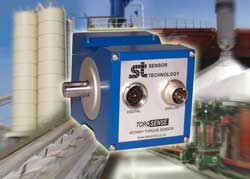
Posted to News on 18th Feb 2009, 11:59
Measuring torque improves control of dry bulk handling
Sensor Technology's TorqSense non-contact torque transducers are being used to achieve much improved control of dry bulk handling.

Dry bulk handling is following many other industrial processes that have been redeveloped from a 'black art' to a highly accurate and controlled procedure. A generation ago much of industry was in the hands of skilled operatives who relied on their experience to ensure a good result. Usually they were unable to explain why they made the decisions they did, but the results generally worked.
Modern industry works to tight margins and timetables, so processes must be controlled to within very demanding tolerances. Computers are crucial to this; however, it is developing the ability for them to monitor what is actually going on and constantly retune the process that is the heart of the matter.
Tony Ingham of Sensor Technology, one of the companies at the forefront of current developments, comments: "Technically we call this real-time data collection. It is the eyes and ears of the computerised system that constantly monitor what is going on. With that information flowing, the computer can then do its bit."
Real-time data is collected by having sensors monitoring the critical variables of an industrial process. This is fed straight to a computer that can perform a number of tasks related to the process. For instance, it can optimise one variable against another, convert raw data to useful information, or collate data for complex analysis.
Measuring torque
However, some critical data can be hard to collect, and that is where Sensor Technology's research into torque monitoring comes in. Nearly all machines are driven by a motor through a rotating shaft, and monitoring the torque, speed and power can provide useful information.
Ingham explains: "Consider a screw conveyor or auger. If this is rotating empty, it requires little power from its drive shaft. If it is half full, it requires rather more, and if it is completely full its needs a lot more. The same goes for speed - the faster, the more power consumed. And the denser the material being conveyed, the more power required.
"So by constantly measuring the torque in the drive shaft, we can determine the volume and weight of material conveyed."
This is important for, say, filling a ship's hold, and if this information is combined with more real-time data, the process becomes highly controllable.
But measuring torque is harder than other parameters. Because the shaft is rotating, wires cannot be attached to it, so a special way of monitoring is required. Slip rings can be used, but these are expensive, difficult to set up and too delicate for most industrial applications.
Torque measurement using sound waves
Sensor Technology stumbled on a solution to this problem some years ago when working on a project for the automotive industry and has been steadily transferring the technology to other industries ever since. Ingham gives the basic principles: "Our technology, called TorqSense, effectively senses and measures the sound waves generated by a rotating shaft and converts them to a torque measurement. Additionally, we do not need physical contact with the SAW [Surface Acoustic Wave], just a radio frequency (RF) pickup close by."
TorqSense torque sensors actually use two tiny SAW devices made of ceramic piezoelectric material containing frequency-resonating combs. These are adhesively bonded to the drive shaft at 90 degrees to one another. As the torque increases, the combs expand or contract proportionally to the torque being applied. In effect, the combs act similarly to strain gauges but measure changes in resonant frequency.
The adjacent RF pickup emits radio waves towards the SAWs, which are then reflected back. The change in frequency of the reflected waves identifies the current torque. This arrangement means there is no need to supply power to the SAWs, so the sensor is non-contact and wireless.
Ingham states: "TorqSense measurement, together with the digital outputs it offers, is often the only practical way to measure torque and integrate it into an industrial environment. And once you are collecting torque data this way, you are well on the way to sophisticated real-time control of complex process."
TorqSense is already in use in many liquid handling applications, in mixers, in the nuclear industry, for testing aerospace components and for running drug trials. It is claimed to be applicable to all sizes, from dispensing active pharmaceutical ingredients, through stirring industrial quantities of cook-chilled curries, to modelling storm and flood water flows
"Dry bulk handling is traditionally thought to be harder to monitor," says Ingham. "But using TorqSense puts it on exactly the same footing as many well established processes."
Use the form on this page to request a callback or more information about TorqSense.
Apollo Park, Ironstone Lane
Wroxton
OX15 6AY
UNITED KINGDOM
+44 (0)1869 238400






























